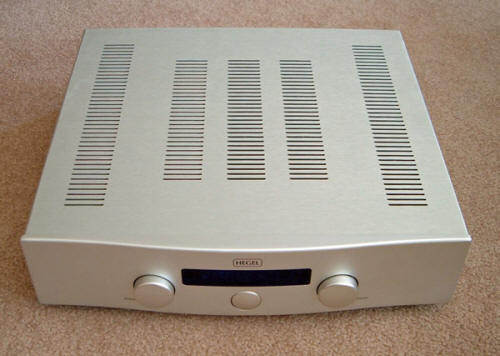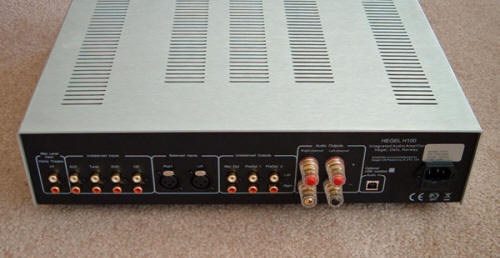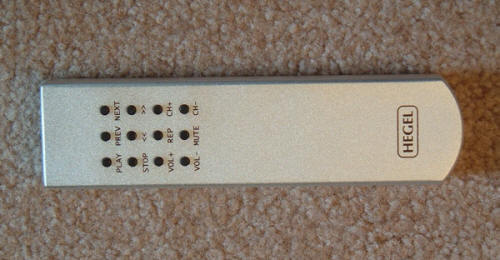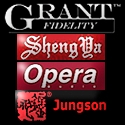You are reading the older HTML site
Positive Feedback ISSUE
46november/december 2009
hegel music systems
H100 integrated amplifier
as reviewed by Kent Johnson

|
KENT JOHNSON'S SYSTEM
LOUDSPEAKERS
ELECTRONICS
SOURCES
CABLES
ACCESSORIES SECOND SYSTEM
LOUDSPEAKERS
ELECTRONICS
SOURCE
CABLES
ACCESSORIES
|
My introduction to Hegel Music System's products came at Rocky Mountain Audio Fest in 2008. Hegel products were feeding GURU loudspeakers and doing it very nicely.
This year, Hegel came to RMAF 2009 with a new US distributor, and they are offering a number of interesting products. These include two CD players, a DAC, two integrated amps, two preamps, and two power amplifiers. All of the Hegel products are solid-state and feature minimalist Scandinavian aesthetics. They have thick solid aluminum front fascias. The top and sides are formed from a single piece of brushed aluminum. Knobs and switches are held to a minimum by both clever design and the shifting of a number of functions to the metal remote control.
I was sufficiently impressed with the sound of the Hegel system that I heard at RMAF 2009 to ask to review one of their integrated amplifiers. I came home with an H100. This is an entry level product for the Hegel line, but at $3000 is certainly not a budget product.
The H100 Integrated Amplifier
The H100 is the less powerful of the two integrated amplifiers that Hegel manufactures. It offers 120 WPC into 8 Ohm and 220 WPC into 4 Ohm loads. This is accomplished using a unique patented amplifier technology. Referred to as "SoundEngine™" this technology limits harmonic distortion to second and third harmonics, while using feed-forward technology to reduce Intermodulation Distortion without reducing the amplifier's damping factor. Here is a short explanation from Hegel's website: HEGEL SoundEngine™ Amplifier Technology
A common problem in high quality sound systems is that the audio signal is distorted on its way from the input to output. HEGEL has designed a unique dynamic error cancelling system called SoundEngine™ Technology, that eliminates this weakness found in all audio amplifiers using serial connected amplifier blocks. Hegel has received a patent for the SoundEngine™ technology. (US 6,275,104)

The 22mm thick front fascia of the H100 has a Source knob on the left. This selects between the one balanced input (which is also the default input when the amplifier is turned on), four RCA line level inputs (no phono), a Home Theater by-pass input, and, if fitted, a USB input. The USB input allows direct connection between a computer and the H100. My sample did not have the USB input. There is a single pair of speaker binding posts. All in/out jacks are of good quality.
The center button is the On/Off switch. The right-hand knob is the volume control. The blue display window indicates the active input and the volume level. Volume reads out numerically from 0 to 99, but defaults to 30 when the amplifier is turned on. A nice feature of the H100 is that, when changing inputs, the amp automatically ramps the volume down to zero and then back up to the previous level—a feature that lessens the chance of the resulting output volume producing an unanticipated shock. The display cannot be turned off.

The small but dense remote fits nicely in the hand. It is logically laid out with 12 small buttons. Four of these buttons control Volume and Source selection for the H100. A fifth Mutes the amp's output. The rest of the buttons are for controlling the Hegel CD players.
Listening
I have made some recent changes to my main system and to my listening room. These include new tubes in my Dodd preamp, a Sony SCD-XA5400ES SACD/CD player, the addition of a PS Audio Soloist feeding AC to my Rogue 90 amplifier, and the completion of some remodeling work on an exterior wall. These changes have resulted in no noise at all through my MG1.6 speakers, SACD and CD playback with noticeably more detail and naturalness, and an even quieter room than I had previously enjoyed. These improvements proved helpful in evaluating the capabilities of the H100.
I put the H100 into my system and connected it to my Sony 5400. It was also plugged into the PS Audio Soloist. I listened first to the familiar sound of Diana Krall's The Look of Love (Verve SACD 314 589 597-2). Diana's voice had lots of nuance and detail. The soundstage was appropriately large and the various accompanying instruments all sounded extremely natural, particularly the piano and flute. While I would not describe the sound as exactly "tube-like," I do think the "SoundEngine" technology's reduction of higher frequency harmonics does produce a very natural sound, slightly to the warm side of neutral.
This naturalness was easily heard in the string reproduction on the CD, To the Winter Sun/Chamber Music by Bruce Stark (MA Recordings M021A). "Hush" is a short string quartet with some very lovely ascending and descending lines. About one-third of the way into the composition, the four string players stop, and each says "Shh" individually. Well, actually, it sounds a little more like "Tchoo"—the quartet members are all Japanese—but the intention is clear. Just before the piece ends, the players say "Shh" again, but in unison. It's very charming. Following the separate lines of the four instruments was easy through the H100, just as the effect of their combined playing was also equally evident. The Hegel amp actually produced a wider soundstage than I had previously heard through my tube components.
"Song of the Whale" is scored for tuba (the whale) and piano. Cymbals are also used; they are played at a very low level. The sound of the cymbals conveys a sense of immense space heading out in all directions. The very delicate decay of piano chords forms the core of this composition, and contrasts with a tuba sound that can best be described as "wistful." It is a very imaginative and lovely work. The Hegel nailed all of its subtleties, but especially the far-reaching sense of space.
Marin Alsop's recording of Brahms' Symphony No. 4 (Naxos 8.570233) with the London Philharmonic Orchestra had a nice sweetness to the strings, along with excellent dynamics and a big presentation through the H100.
Recording together as "The Swell Season," Glen Hansard and Marketa Irglova have released a new CD; it follows up on their successful Once soundtrack. Titled Strict Joy, the CD's name derives from the poem "Strict Joy," by James Stephens.
The only copy of this CD that I could find locally was the deluxe edition that includes a live concert CD and DVD, as well as the Strict Joy disc itself. I have to admit that, so far, all I have listened to is the live CD, An Evening at the Riverside Theater. It is absolutely wonderful. Musically and sonically it is a delight in every way. Many of the songs on this disc are from the Once soundtrack. (Anti-87052-2) The first track, "All the Way Down," sung by Marketa and accompanied by Glen, is beautiful. There is reverberation off of her voice that I can best describe as "massive"; it clearly delineates the huge space surrounding them. Sonically, it is pure audiophile overload played through the Sony and Hegel tandem.
Track 7, "Falling Slowly," features Glen and Marketa's voices, as well as the Whitefish Bay Eighth Grade Choir backing them. About two-thirds of the way through the song, Glen can be heard saying, "Sing by yourselves" to the choir. They do, and it is very lovely. There is a hesitation in their voices, the sense of their being somewhat overwhelmed by the situation, but they still do a great job. When their voices all rise at "...we still have time," the audience goes crazy. Their enthusiasm makes you wonder if the entire audience is composed of the parents of the kids in the choir. Anyhow, the sense of an expansive space, large crowd, and numerous voices was superbly reproduced by the H100.
All of the Rudy Van Gelder Re-masters that I have heard have had impressive sound. Ron Carter's Where (Prestige PRCD-30648) is no exception. The H100 brought to life details on the track "Bass Duet" that I had not heard previously, and did it effortlessly thanks to the substantial power available. It is sometimes easy to forget what a nice thing having plenty of power is.
For curiosity's sake as much as anything else, I played Super Tramp's Breakfast in America. I found this CD recently at a garage sale. I have not heard this recording, except as background music, since I lost it (and the rest of my records and stereo system) in my divorce in 1980. Played through the 5400 and H100, it was very impressive sounding. For the first time, I clearly heard the huge soundstage and all of the effects within it. It was far, far better than I had ever heard it before. And it was also a lot more intelligible. The Hegel amp did a wonderful job with this music. Maybe a lot of the music that I listened to in the late 70s wasn't as bad as I remember it.
Summary
By this point in my review, I suppose you can guess that I can recommend the H100 without any reservations. It is not a flashy amplifier either in appearance or performance; rather it is an elegant player in both categories. It simply puts the music out into the room, and lets it happen: whether that music is solo voice, small ensemble, rock group, or large orchestra. I have to admit that I am increasingly drawn to the simplicity of a system built around a musically-satisfying integrated amplifier such as this one.
I thoroughly enjoyed the H100, and could easily be happy with it as a long-term part of my system. Kent Johnson
H100
Retail: $3000
Hegel
web address:
www.hegel.com
USA Distributor
Hegel Music
System USA
Fairfield,
Iowa
Contact: Ben or Eileen Gosvig
email address:
[email protected]
TEL: 641-209-3210


